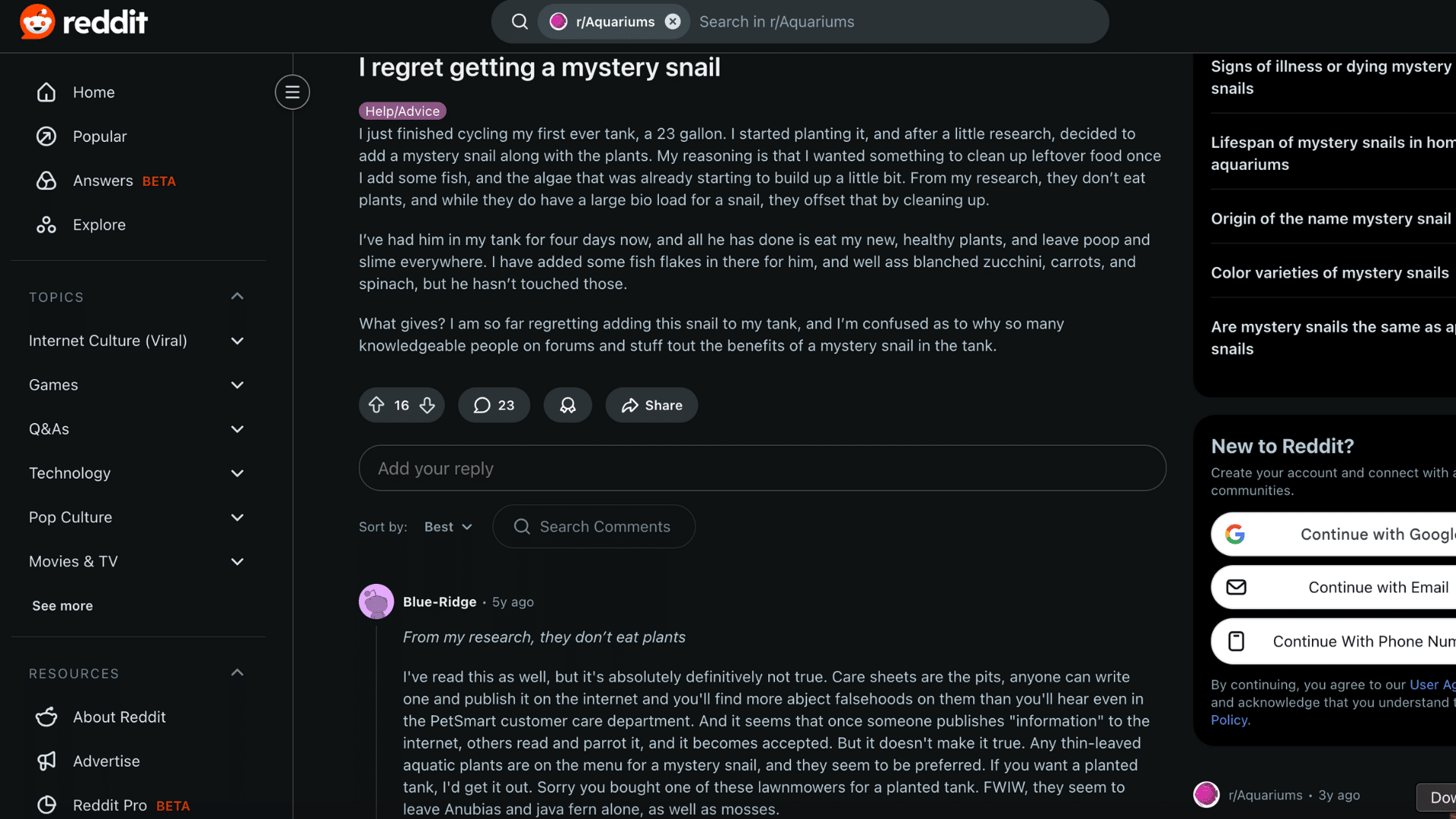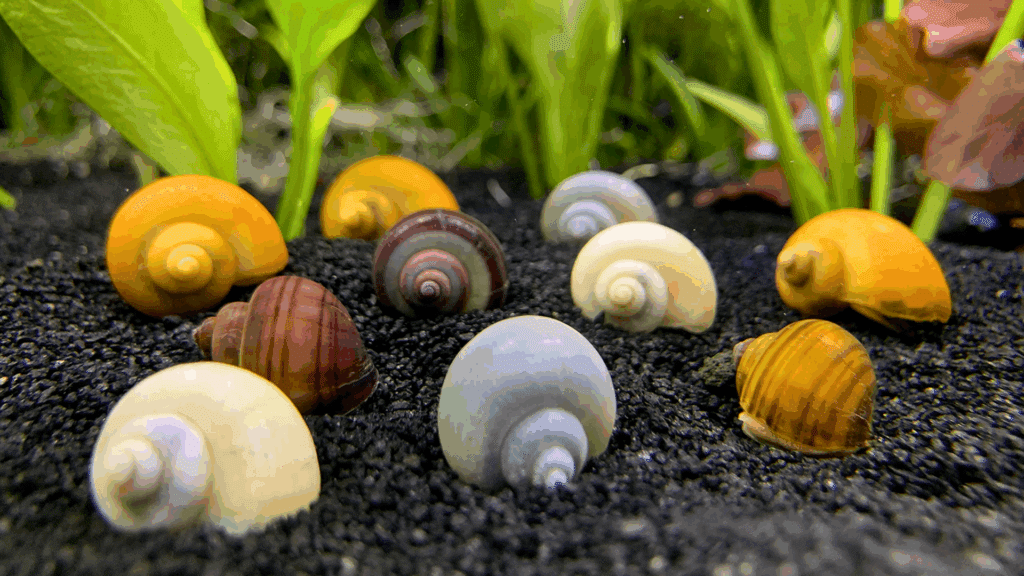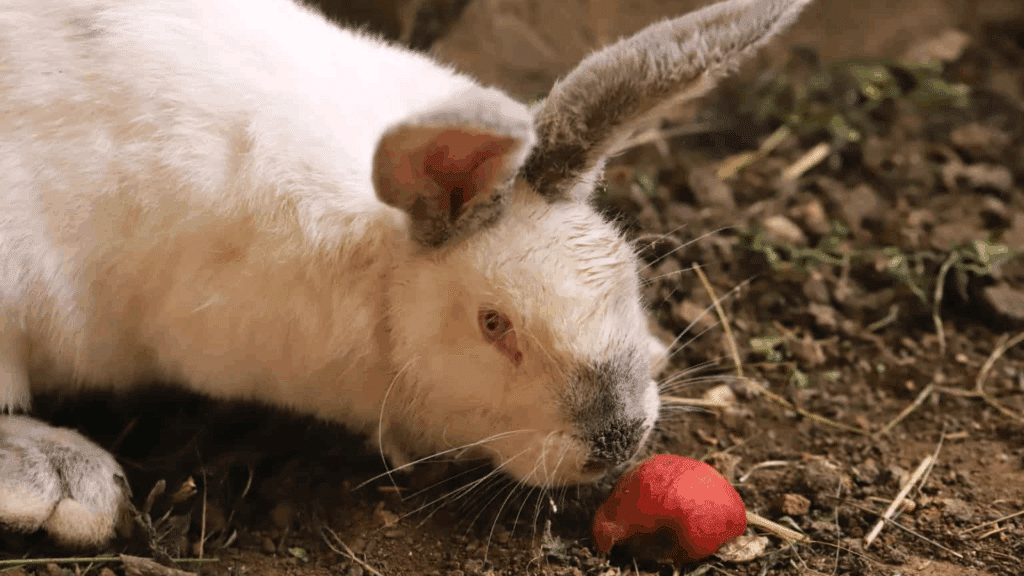Mystery snail care can seem simple at first, but these tiny creatures have more personality than most people expect.
When I brought my first mystery snail home, I thought it would just eat algae and sit quietly in the tank. Instead, it became one of the most entertaining parts of my aquarium.
In this guide, I’ll share everything I’ve learned about keeping mystery snails healthy and happy, including:
- What and how to feed them
- How breeding really works
- How long they live and what helps them thrive
You’ll find honest lessons from my experience and from other snail owners on Reddit, the good and the surprising.
If you’re curious about owning a mystery snail, this guide offers simple care tips and real stories.
What is a Mystery Snail?
When I first got a mystery snail, I didn’t expect much; it looked like a simple, slow-moving shell.
But after a few days, I realized how different it is from other snails. These snails are peaceful, quiet, and surprisingly active once they settle in.
You’ll often see them gliding along the glass or stretching their long antennae to explore every corner.
What makes them stand out is their color variety, from golden to blue or even purple shells; each one looks special.
They’re also great little cleaners, eating leftover food and algae that build up in the tank. Still, don’t assume they can care for themselves.
They need clean water, enough food, and a safe tank to stay healthy.
Watching them move slowly but with purpose can be calming; it’s one of the reasons I enjoy keeping them so much.
Quick Facts About a Mystery Snail
Before getting a mystery snail, it helps to know a few basics. These simple details make caring for them easier and help you build the right tank setup.
| Feature | Details |
|---|---|
| Average Size | Grows up to 2 inches in diameter when fully mature. |
| Lifespan | Lives about 1–2 years with proper care and clean water. |
| Tank Size | Needs at least a 5-gallon tank per snail for enough space. |
| Temperament | Very peaceful; won’t harm fish or other snails. |
| Tank Mates | Gets along well with calm fish and shrimp species. |
| Fun Fact | They breathe through a siphon, a small tube that reaches above the water’s surface for air. |
Setting up a Home They’ll Love
When I set up my first tank for mystery snails, I thought any small aquarium would do. I quickly learned they need more space and better water flow than I expected.
Now, I use a 5-gallon tank per snail with a gentle filter that keeps the water clean and calm.
I like to include live plants such as Java fern and anubias since they’re safe and give the snails places to rest and move around.
One mistake I made early on was overcrowding; it made the water dirty faster and stressed the snails.
Keeping the tank lightly stocked and cleaning it regularly keeps them healthy and active. A simple setup with space, balance, and good water quality is all they need to feel at home.
Water Conditions that Keep Them Happy

Keeping the right water conditions makes a big difference for mystery snails. I keep the temperature between 72°F and 82°F and aim for a pH of 7.2 to 8.0.
They prefer slightly hard, clean water, so I use a basic test kit once a week to check levels.
I also do small water changes every few days to prevent waste buildup. When something’s off, my snails show it right away; they may stop moving, float for hours, or hide for too long.
If I see these signs, I check the water and filter first. Sometimes it’s just low oxygen or high ammonia.
Keeping the tank balanced takes a bit of routine work, but it’s worth it. Healthy water means active, bright snails that stay lively and strong.
What Do Mystery Snails Eat?
Mystery snails aren’t picky eaters, but feeding them the right mix keeps them healthy and active. I’ve tried different foods to see what they enjoy most, and here’s what works best.
- Algae wafers: Their go-to meal; easy to digest and full of nutrients.
- Blanched veggies: Zucchini, spinach, and cucumber are favorites.
- Calcium-rich foods: Crushed eggshells or cuttlebone help keep shells strong.
- Snail or shrimp pellets: A good backup when fresh food isn’t available.
- Occasional treats: Peas or lettuce pieces, offered once or twice a week.
- Feeding routine: Once a day in small amounts; remove leftovers after a few hours.
- Avoid: Anything salty, seasoned, or processed, as it harms their shells and health.
How Mystery Snails Behave?
Mystery snails have their own little routines that make them fun to watch. During the day, I often see mine crawling slowly along the glass or munching on algae.
At night, they become more active, gliding across the tank or climbing plants.
Sometimes they float at the top, which can look strange, but it’s often just them taking in air through their siphon. They also love to climb, even to the very top of the tank, and rest upside down for a while.
If your snail isn’t moving much, hides all day, or stays closed in its shell, it might be stressed or unwell. Poor water conditions or sudden changes can cause this.
Once you keep the water clean and steady, they usually go back to their calm, steady routine.
Feeding Tips and Common Mistakes
Feeding mystery snails seems simple, but a few small mistakes can cause big tank problems. These are some tips I learned from trial and error to keep feeding balanced and safe.
1. Avoid Overfeeding
It’s easy to think your mystery snail needs more food than it really does. I made this mistake early on and noticed cloudy water and algae starting to grow fast.
Too much food breaks down and releases ammonia, which can harm your snails and fish.
Feed them only what they’ll actually eat. Remember, they also graze on algae and leftover bits in the tank. Once I reduced the portions, the water stayed much cleaner, and the snails stayed just as healthy.
2. Feed in Small Portions
I learned that small, steady feedings are much better than dumping in a large amount.
I usually drop a small piece of blanched veggie or half an algae wafer and watch how long it takes them to finish. They can eat slowly, so patience helps.
If the food is still there after two hours, it’s too much. Smaller feedings keep the tank balanced and prevent waste from collecting at the bottom.
3. Watch Their Behavior
Your snail’s behavior can tell you a lot about how much to feed. When they’re hungry, they’ll move quickly toward the food and stay active.
If they ignore it or seem sluggish, that’s a sign you might be overfeeding or something’s off with the water.
I use these small cues to adjust my routine. Paying attention for a few minutes each feeding time helps me keep their diet just right.
4. Remove Leftovers
One of the simplest but most important things I do is remove leftover food.
Any uneaten food starts to rot within hours, which releases waste into the water and lowers the quality fast.
I use a small net or turkey baster to pick up what’s left after a couple of hours. It takes just a minute but makes a big difference in keeping the tank fresh and safe.
5. Mix Their Diet
Mystery snails do best with variety. I rotate between algae wafers, blanched spinach or zucchini, and calcium sources like crushed eggshells or cuttlebone.
The calcium keeps their shells strong and prevents cracking or thinning. Every few days, I switch things up to make sure they get a mix of nutrients.
A balanced diet keeps them active, colorful, and growing at a healthy rate.
6. Learn from Observation
I didn’t figure out the perfect feeding amount overnight; it took time. I watched how fast my snails finished food and how the water looked the next day.
If it stayed clear, I knew I got it right. If it turned cloudy, I cut back.
Every tank is a little different depending on size, filtration, and how many snails you have. Learning through observation helped me find the balance that works.
7. Stick to a Routine
Mystery snails like consistency. Feeding them around the same time every day keeps them active and makes it easier to spot changes in their behavior.
I feed mine in the evening when they’re most active.
After a while, I noticed they started moving toward the feeding spot on schedule. It’s a small habit that helps them stay healthy and keeps their tank on a steady rhythm.
What Do Other Owners Say Online?

When I first looked up mystery snails on Reddit, I found mixed reviews. One post titled “I regret getting a mystery snail” caught my attention.
The owner said their snail was eating new plants and leaving waste everywhere, which made them question why so many people recommended them.
Others jumped in to explain that this often happens when plants are weak or the snail isn’t fed enough.
Some mentioned that many stores accidentally sell apple snails, which look similar but are known for eating live plants.
A few experienced keepers said their mystery snails never damaged healthy plants and only ate melting or dying leaves. One user even said their snails were “super cleaners” who kept tanks spotless.
After reading these comments, I realized that results depend on care and setup. From my experience, mystery snails behave well when properly fed and housed.
They’re not lazy cleaners; they just need balanced care and patience to show their best side.
Checking for Good Health
A healthy mystery snail is easy to spot once you know what to look for. Their shell should be smooth and firm, with even color and no cracks.
They move around often, eat regularly, and react when touched or when the light changes.
If your snail stops moving for long periods, floats constantly, or hides in its shell, something might be wrong.
I once had a snail with a cracked shell, and adding calcium supplements along with clean, stable water helped it heal.
When one became inactive, I checked the water and found high ammonia levels; fixing that brought it back to normal.
Regular tank checks and small water changes go a long way in keeping them healthy. Paying attention to these small signs helps you act early before problems get serious.
Breeding Mystery Snails: How It Actually Works?
Breeding mystery snails sounds exciting, but it can quickly turn into more work than you expect. Here’s what really happens when your snails start laying eggs and what you should prepare for.
- Egg Laying: Mystery snails lay eggs above the waterline, usually as pink or white clumps that stick to the tank lid or glass.
- Temperature and Humidity: Eggs need warm and humid air to hatch, around 75–80°F. Too much moisture can make them rot.
- Hatching Time: It can take 3–4 weeks for the eggs to hatch, and the number of babies can reach over a hundred.
- Caring for Babies: Move hatchlings to a separate tank with clean, shallow water. Feed them crushed algae wafers and soft veggies.
- Tank Maintenance: Baby snails produce a lot of waste, so frequent water changes are a must.
- Population Control: If you’re not ready for dozens of snails, remove some egg clutches early.
Lifespan and Growth: What to Expect Over Time

Mystery snails usually live about one to two years, though some can reach three with good care. Their lifespan depends a lot on water quality, diet, and tank conditions.
Clean water, stable temperature, and enough calcium keep them healthy as they grow.
I’ve learned that even small things, like skipping water changes or overfeeding, can shorten their life.
When I lost my first snail, I realized how much those details matter. The ones I cared for carefully lived longer, stayed active, and kept their shells strong.
Watching them grow from tiny shells into full-sized snails over the months is rewarding.
If you keep up with regular cleaning, balanced feeding, and stable water levels, your snail will likely stay with you for a long time, gliding peacefully around the tank.
Common Problems and How to Fix Them
Even with the best care, mystery snails can face a few issues. Most of them are easy to fix once you know what’s wrong.
- Algae Buildup: Too much algae means too many nutrients in the water. I reduced feeding, cleaned the glass weekly, and made sure my filter was working properly.
- Cloudy Water: This usually happens from leftover food or dirty gravel. I fixed it by doing small, regular water changes and cleaning uneaten food within a few hours.
- Shell Erosion: If the shell starts to thin or pit, it’s a sign of low calcium or acidic water. I added crushed eggshells and kept the pH between 7.2 and 8.0.
- Inactivity or Floating: Sometimes they float when oxygen is low or the water is dirty. A quick water test and a filter check usually solve it.
- Bad Odor or Rot: If you notice a strong smell, check for dead snails or decaying food right away. Clean the tank, change part of the water, and monitor closely.
Simple fixes like balanced feeding, clean water, and regular testing usually prevent these issues from coming back.
Conclusion
Caring for mystery snails has taught me a lot about patience and attention to detail. They move slowly, but watching them clean, climb, and explore reminds me that small efforts matter.
Keeping their tank balanced takes consistency, but the reward is seeing them grow and stay active.
For beginners, I’d definitely recommend mystery snails; they’re peaceful, easy to handle, and great for learning the basics of aquarium care.
Just remember, they need clean water, a good diet, and some time to adjust.
Once you get into the routine, they become one of the most relaxing pets to watch. Their quiet movements add life to any tank without much trouble.
So, what do you think, would you keep a mystery snail in your tank?








